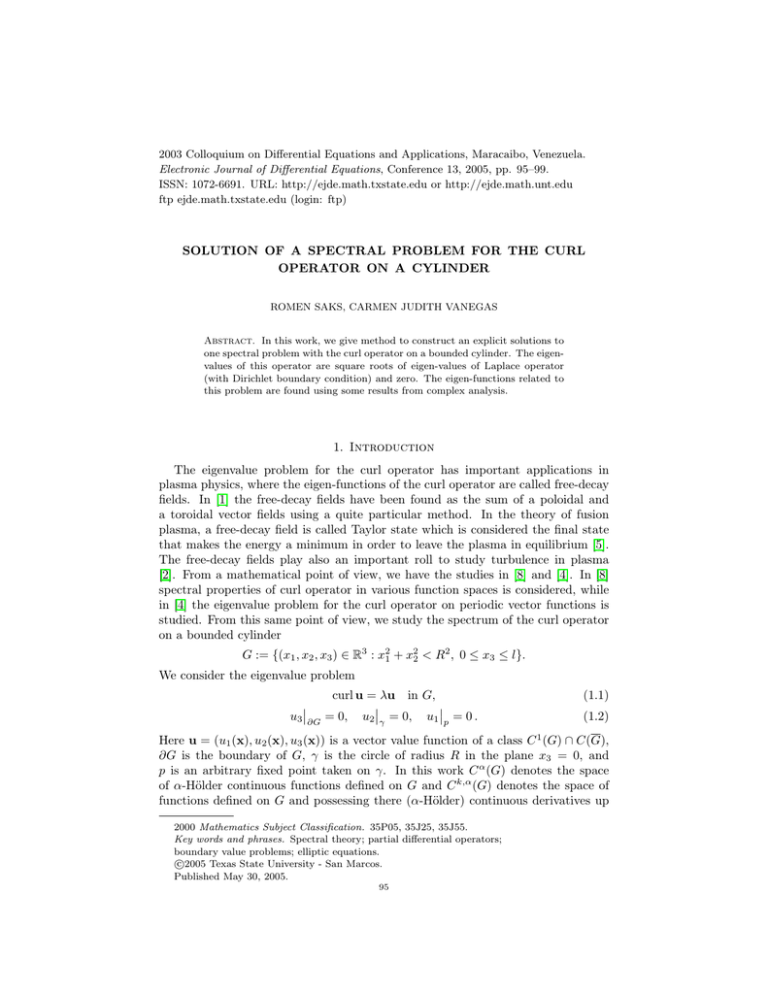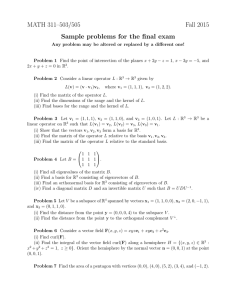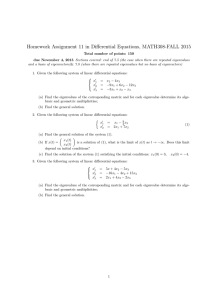2003 Colloquium on Differential Equations and Applications, Maracaibo, Venezuela.
advertisement

2003 Colloquium on Differential Equations and Applications, Maracaibo, Venezuela.
Electronic Journal of Differential Equations, Conference 13, 2005, pp. 95–99.
ISSN: 1072-6691. URL: http://ejde.math.txstate.edu or http://ejde.math.unt.edu
ftp ejde.math.txstate.edu (login: ftp)
SOLUTION OF A SPECTRAL PROBLEM FOR THE CURL
OPERATOR ON A CYLINDER
ROMEN SAKS, CARMEN JUDITH VANEGAS
Abstract. In this work, we give method to construct an explicit solutions to
one spectral problem with the curl operator on a bounded cylinder. The eigenvalues of this operator are square roots of eigen-values of Laplace operator
(with Dirichlet boundary condition) and zero. The eigen-functions related to
this problem are found using some results from complex analysis.
1. Introduction
The eigenvalue problem for the curl operator has important applications in
plasma physics, where the eigen-functions of the curl operator are called free-decay
fields. In [1] the free-decay fields have been found as the sum of a poloidal and
a toroidal vector fields using a quite particular method. In the theory of fusion
plasma, a free-decay field is called Taylor state which is considered the final state
that makes the energy a minimum in order to leave the plasma in equilibrium [5].
The free-decay fields play also an important roll to study turbulence in plasma
[2]. From a mathematical point of view, we have the studies in [8] and [4]. In [8]
spectral properties of curl operator in various function spaces is considered, while
in [4] the eigenvalue problem for the curl operator on periodic vector functions is
studied. From this same point of view, we study the spectrum of the curl operator
on a bounded cylinder
G := {(x1 , x2 , x3 ) ∈ R3 : x21 + x22 < R2 , 0 ≤ x3 ≤ l}.
We consider the eigenvalue problem
u3 ∂G
curl u = λu in G,
= 0, u2 γ = 0, u1 p = 0 .
(1.1)
(1.2)
Here u = (u1 (x), u2 (x), u3 (x)) is a vector value function of a class C 1 (G) ∩ C(G),
∂G is the boundary of G, γ is the circle of radius R in the plane x3 = 0, and
p is an arbitrary fixed point taken on γ. In this work C α (G) denotes the space
of α-Hölder continuous functions defined on G and C k,α (G) denotes the space of
functions defined on G and possessing there (α-Hölder) continuous derivatives up
2000 Mathematics Subject Classification. 35P05, 35J25, 35J55.
Key words and phrases. Spectral theory; partial differential operators;
boundary value problems; elliptic equations.
c
2005
Texas State University - San Marcos.
Published May 30, 2005.
95
96
R. SAKS & C. J. VANEGAS
EJDE/CONF/13
to order k. The subspace of C k,α (G) consisting of all the functions of compact
support in G \ ∂G will be denoted by Cok,α (G).
2. The eigenvalues of the curl operator
If λ = 0, curl u = 0 on G, and for wk ∈ C02 (G), k = 1, 2, . . . , then
uk = ∇wk (x),
uk = 0 ;
∂G
i.e., we have infinitely many solutions (0, ∇wk ), k = 1, 2, . . . of the eigenvalue
problem (1.1), (1.2).
For the case λ 6= 0 , we apply the divergence and curl operators to (1.1), and
obtain
div u = 0, and − ∆uj = λ2 uj , for j = 1, 2, 3.
For j = 3, let us consider the eigenvalue problem
−∆u3 = λ2 u3
in G,
u3 = 0 on ∂G.
(2.1)
(2.2)
The solutions of this problem are well known. We shift to cylindrical coordinates
(r, θ, z) obtaining, after a straightforward calculation, the eigenvalues λ2κ with
s
ρ2k,j
m2 π 2
λκ =
+ 2 , k = 0, 1, . . . ; j = 1, 2, . . . ; m = 1, 2, . . . ,
(2.3)
2
R
l
where κ = (k, j, m) is multi-index and ρk,j are the positive roots of the Bessel
function Jk (z).
The corresponding eigen-functions are
√
mπ
2
r
κ
√
u3 =
z).
(2.4)
Jk (ρkj ) exp(ikθ) sin(
0
R
l
lπ R |Jk (ρkj )|
As λ2κ > 0 the real and imaginary parts of uκ3 are eigen-functions also and they
form the real orthonormal basis in the space L2 (G).
We have the following result.
Theorem 2.1. The eigenvalue λ = 0 of problem (1.1)-(1.2) has an infinite multiplicity. In the case λ 6= 0, we find the eigenvalues ±λκ for (1.1)-(1.2) through the
eigenvalues λ2κ of the problem (2.1)-(2.2)); and λκ is given by (2.3); the multiplicities of λκ and −λκ are equal and finite. The spectrum for problem (1.1)-(1.2) is a
point spectrum and does not have finite limits point.
3. Determining eigen-functions via complex analysis
In this section, we obtain the eigen-functions of problem (1.1)-(1.2) using some
results from complex analysis. We write the eigen-functions as uκ = (uκ1 , uκ2 , uκ3 ),
where uκ3 has been already found in the former section and it is the real (or imaginary) part of uκ3 represented by the expression (2.4). To find uκ1 and uκ2 we consider
the complex function ω = uκ2 + i uκ1 . After this definition and substituting λ by λκ
and u3 by uκ3 , we obtain the following complex form of (1.1):
∂3 ω − iλκ ω = 2i∂z uκ3
2 Re ∂z̄ ω −
λκ uκ3
= 0,
(3.1)
(3.2)
EJDE/CONF/13
SOLUTION OF A SPECTRAL PROBLEM
where z = x1 + i x2 and
97
∂
1 ∂
∂
= (
−i
)
∂z
2 ∂x1
∂x2
.
The general solution of the differential equation (3.1) is
ω(x) = ω0κ (x) + ω1 (x’) exp(iλκ x3 ),
where
ω0κ (x) = 2i
x’ = (x1 , x2 ) ,
(3.3)
x3
Z
exp(iλκ (x3 − t))∂z uκ3 (x’, t)dt
0
and ω1 (x’) is a function in C 2,α which will be specified later on.
We observe that ω0κ (x) ∈ C 2,α (G) if uκ3 ∈ C 3,α (G).
On the left side of (3.2) we replace ω by the particular solution ω0κ of (3.1) and
this side will be called V0 . We will need the following lemma.
Lemma 3.1. If uκ3 ∈ C 3,α (G) is a solution of (2.1) (with λ2 = λ2κ ) on G then V0
satisfies, on G, the equation
∂ 2 V0
+ λ2κ V0 = 0.
∂x23
Moreover V0 can be represented in the form
V0 (x) = Re(v0 (x’) exp(iλκ x3 )),
(3.4)
(3.5)
where
i ∂V0 (x) ) x3 =0 = i(∂3 uκ3 )x3 =0 .
λκ ∂x3
∂2 −∂1
Proof. When we apply the matrix differential operator
, where ∂i = ∂∂xi
∂1 ∂2
for i = 1, 2, to the first two equations of system curl u = λu, where λ = λκ ,
u = (uκ1 , uκ2 , uκ3 ) and ω0κ = uκ2 + iuκ1 , and taking into account (2.1), we obtain the
equations
v0 (x’) = (V0 (x) −
−∂3 (λ div u) + λ2 V0 = 0
∂3 V0 + λ div u = 0 .
Because V0 and ∂3 V0 belong to the space C 1,α (G), we obtain the desired result. Substituting the ω given by (3.3) in the left side of (3.2), we obtain
2 Re ∂z̄ (ω1 (x’) exp(iλκ x3 )) + V0 = 0.
Using representation (3.5), this last equation can also be written as
Re((2∂z̄ ω1 (x’) + v0 (x’)) exp(iλκ x3 )) = 0,
from which it follows
2∂z̄ ω1 (x’) + v0 (x’) = 0.
(3.6)
Therefore, the solvability condition for the last equation of system (1.1) is
1
∂z̄ ω1 (x’) = − v0 (x’)
(3.7)
2
It is known [6] that the general solution of the inhomogeneous Cauchy-Riemann
system (3.7) is
Z
1
v0 (ξ, η)
dξdη, ζ = ξ + iη,
(3.8)
ω1 (x’) = Φ(z) −
2π D z − ζ
98
R. SAKS & C. J. VANEGAS
EJDE/CONF/13
where D is the disc |x| < R, x3 = 0 and Φ(z) is a function in C 2,α (D̄), holomorphic
in D which will be determined soon.
Taking (3.3) and (3.8) into account we have
ω(x) = ω2κ (x) + Φ(z) exp(iλκ x3 )
(3.9)
where
1 Z v (ξ, η)
0
=
+
dξdη exp(iλκ x3 )
2π D ζ − z
which belongs to C 2,α (G) ∩ C α (Ḡ) [7]. If x3 = 0 the function ω0κ (x) = 0 by
definition. Since uκ2 + iuκ1 = ω(x), according to the solution (3.9), we obtain
ω2κ (x)
ω0κ (x)
Re Φ(z) = − Re ω2κ (x0 , 0) on γ
Im Φ(z) = − Im ω2κ (p), for p = (p1 , p2 , 0) ∈ γ.
(3.10)
(3.11)
p
Now we use (3.10) and (3.11), and the Schwartz Formula [3] to specify the function
Φ(z):
Z
t + z dt
1
Re ω2κ (t, 0)
+ i C1 .
Φ(z) = −
2πi γ
t−z t
where
Z
h
1
t + z dt i
C1 = −Im ω2κ (p0 , 0) +
Re ω2κ (t, 0)
, for z = p1 + ip2 .
2πi γ
t−z t
Therefore, we have
uκ1 (x) = Im ω2κ (x) + Φ(z) exp(iλκ x3 )
uκ2 (x) = Re ω2κ (x) + Φ(z) exp(iλκ x3 ) .
(3.12)
(3.13)
Then we arrive to the following result.
Theorem 3.2. The components of the vector value eigen-function uκ of problem
(1.1)-(1.2) associated to a positive eigen-value λκ expressed by (2.3) are given by
(3.12), (3.13) and real (or imaginary) part of (2.4) respectively. Moreover, if we
replace λκ by −λκ in (3.3),..., (3.12), (3.13), we obtain the eigen-function uκ− of
problem (1.1)-(1.2) associated to a negative eigen-value −λκ .
Thus, we have shown: on one side for any solution (λκ , uκ ) of the problem (1.1)(1.2) a pair (νκ , v κ ) is a solution of the problem (2.1) -(2.2), where νκ = λ2κ and
v κ = (uκ , e3 ) = uκ3 is a projection of the vector-function uκ on the ax of cylinder
e3 . Evidently, if the pair (−λκ , uκ− ) is another solution of the problem (1.1)-(1.2) a
κ
pair (νκ , v−
) is also a solution of the problem (2.1)- (2.2) (with same νκ = λ2κ and
κ
κ
v− = (u− , e3 ) 6= v κ in general case).
On other side, for any solution (νκ , v κ ) of the problem (2.1)- (2.2) (with a real
function v κ ), we have constructed two solutions (λκ , uκ ) and (−λκ , uκ− ) of the
√
problem (1.1)-(1.2) such that λκ = νκ and (uκ , e3 ) = (uκ− , e3 ) = v κ .
Now Theorem 2.1 follows from these relations and properties of eigen-values of
the problem (2.1)-(2.2) (see [7], f.e.).
Remark. Later (in 2004) we have calculated the components of eigen-functions
uκ and uκ− directly using the series representation of (2.4), which in variables
(x1 , x2 , x3 ) has the form
uκ3 = aκ (x1 + ix2 )k sin(
∞
2
2 p
X
(−1)p ρ2p
mπ
k,j (x1 + x2 )
x3 )
.
2p
l
(2R) p!(p + k)!
p=0
(3.14)
EJDE/CONF/13
SOLUTION OF A SPECTRAL PROBLEM
99
These results will be published.
A short review of the physical background for the eigenvalue problem of the curl
operator in a 3-dimensional bounded domain, with another boundary condition,
can be found in [8].
References
[1] Chandrasekhar S., Kendall P. C.; On force-free magnetic fields, Astrophys J. 126 (1957) p.
457-460.
[2] Montgomery D., Turnel L., Vahala G.; Three-dimensional magnetohydrodynamic turbulence
in cylindrical geometry, Phys. Fluids 21 (1978), 757-764 .
[3] Muskhelishvili N. I.; Singular integral equations, Noordhoff, Groningen - Holland (1953).
[4] Saks R. S.; On the spectrum of the operator curl, Functional-Analytic and Complex Methods,
their Interactions, and Applications to Partial Differential Equations, World Scientific, New
Jersey-London-Singapore-Hong Kong, 58-63 (2001).
[5] Taylor J. B.; Relaxation of toroidal and generation of reverse magnetic fields, Phys. Rev. Lett.
33 (1974), No. 19, 1139-1141.
[6] Tutschke W.; Complex methods in the theory of initial value problems, Complex Methods for
Partial Differential Equations, Kluwer Academic Publishers, Dordrecht-Boston-London (1999).
[7] Vladimirov V. S., Equations of mathematical Physics, Marcel Dekker, INC., New York (1971).
[8] Yoshida Z., Giga Y.; Remarks on spectra of operator rot, Math. Z. 204 (1990), 235-245 .
Romen Saks
Bashkir State University, 32, Frunze street, 450074 Ufa, Russia
E-mail address: saks@ic.bashedu.ru
Carmen Judith Vanegas
Department of Mathematics, Universidad Simón Bolı́var, Sartenejas-Edo. Miranda, P.
O. Box 89000, Venezuela
E-mail address: cvanegas@usb.ve






